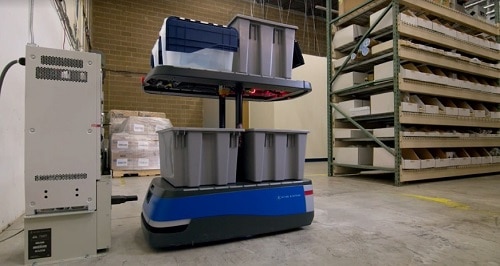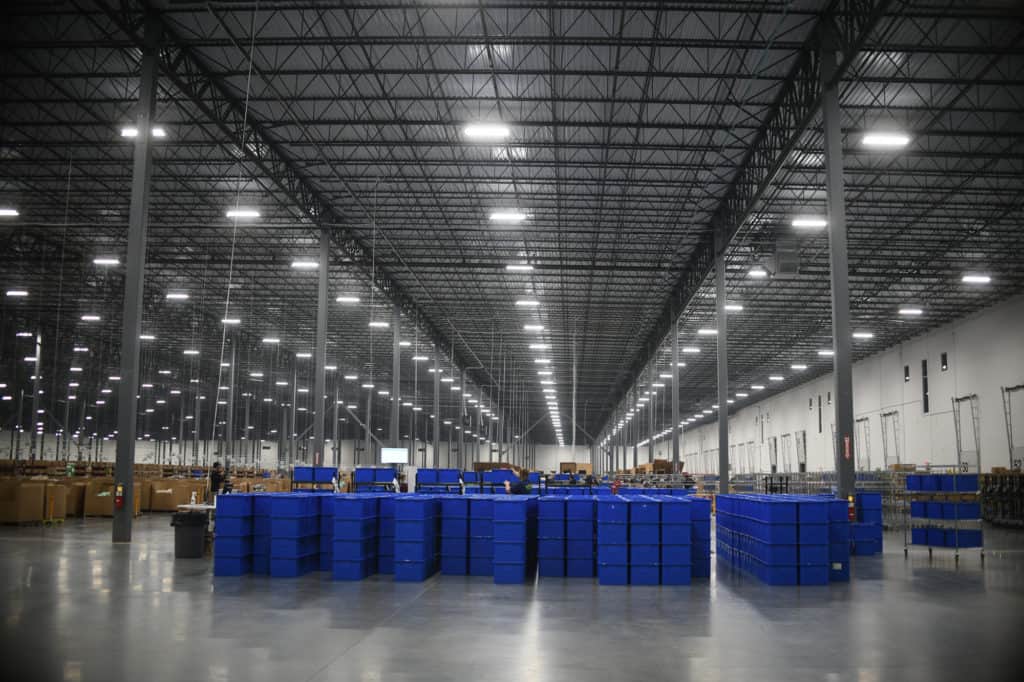Warehouse robotics refers to the use of automated systems, robots and specialized software to transport materials, perform various tasks and streamline/automate warehouse processes. In recent years, robotics has gained eminence in supply chain, distribution center, and warehouse management circles and continues to play a significant role in warehouse automation. Here are some of the different types of warehouse robots.
Types of warehouse robotics

Technological advancements and an increasingly competitive business landscape are forcing modern warehouses to seriously consider the use of robotics. With their ability to increase productivity, accuracy and operational efficiency, warehouse robots are no longer nice-to-have accessories — they have become indispensable to efficient warehouse operations. Warehouse automations of all kids add value to warehousing operations by automating the execution of menial, repetitive tasks, thus allowing human workers to focus on more complicated tasks.
So, what are some types of robots? To better understand the ROI of these automation technologies, let’s take a look at some of the common types and uses of warehouse robotics.
Automated Guided Vehicles (AGVs)
Automated guided vehicles help to transport materials, supplies, and inventory within warehouse facilities. AGVs are used in operations to replace manually-driven forklifts or pick carts. Some AGVs autonomously navigate warehouse facilities by following established routes that are marked by wires, magnetic strips, tracks, sensors embedded in the floor or other physical guides. Other AGVs utilize cameras, lidar, infrared and other advanced technology to navigate workspaces, identify obstacles and avoid collisions.
Automated storage and retrieval systems (AS/RS)
AS/RS refers to a group of computer-controlled systems that help automate inventory management and store/retrieve goods on demand. These systems are designed to facilitate speedy retrieval and placement of products and are usually paired with warehouse execution software. They operate either as cranes or shuttles on fixed tracks and can easily traverse product aisles and vertical heights to deposit or remove items. AS/RS systems are used in warehouse environments to speed up order fulfillment and materials handling operations.
“Cobots” or collaborative robots
Collaborative robots are semi-autonomous mobile robots designed to help human workers perform diverse tasks in the warehouse environment. Some collaborative robots follow human pickers around the warehouse floor and act as mobile storage bins for picked orders. Others direct workflows through the warehouse, leading associates and transporting loads. Collaborative robots come with sensors that enable them to distinguish between obstacles and boxes, thus ensuring accurate navigation through the facility. They can also help speed up order fulfillment by delivering picked orders to workers in other locations in the warehouse such as sorting or packing stations.
Articulated robotic arms
Articulated robotic arms, a type of pick-and-place robot, are multi-jointed limbs used to manipulate products within distribution centers and warehouses. Since these arms can move, turn, lift and maneuver items, they can be used in the following warehouse operations:
- Picking/packing
- Receiving/storage
- Palletizing
Goods-to-person
Goods-to-person (G2P) technology operates on the same principle as an AS/RS system. G2P technology leverages an automated storage system to deliver items to stationary pick stations where human operators fulfill orders. While G2P systems have the potential to deliver the highest returns on investment, they do require significant infrastructure changes which contribute to high capital investments and downtime during implementation.
Benefits of warehouse robotics
Savvy companies are leveraging warehouse robotics to improve order fulfillment and better manage inventory while staying ahead of the competition. Warehouse robotics helps cut down on the time and resources spent on retrieving and transporting items around the warehouse floor, allowing human workers to concentrate on more complicated processes like packing and shipping orders. While increased efficiency and lower costs are obvious benefits of deploying robots in your warehouse, there are several additional benefits to consider, which we’ll discuss below.
Improved accuracy
Investing in warehouse robotics results in increased productivity and accuracy in inventory management. Human errors can be quite costly for businesses and can lead to lower customer satisfaction. Warehouse robotics automates the handling, picking, sorting, and replenishment of products with precision, thus guaranteeing high levels of accuracy in order fulfillment and warehousing operations.
Reduced physical and mental strain on human workers
Robots in warehousing take on the time-consuming, stressful and dangerous aspects of warehouse operations, such as transporting inventory and retrieving inventory from heights. By taking on some dangerous and stressful tasks, warehouse robots reduce physical and mental strain on human workers. Reduced strain on workers also leads to an increase in morale, which boosts productivity and creates a better work environment.
Automate tedious, manual tasks
Warehouses can increase operational efficiency, lower error rates and execute order fulfillment operations with more accuracy by deploying the right robots. Warehouse robots automate tedious, manual tasks so that human workers can focus their time and energy on handling complicated tasks that require fine motor skills or critical thinking.
Common warehouse robotics use cases

Robotics play a vital role in warehouse automation and continue to address common challenges in supply chain management, including:
- More complicated fulfillment strategies
- Changing order profiles
- Rising employment costs and wages
- Decreased labor availability in the market
In particular, robotics can be used to aid the following warehouse operations.
Picking
Picking is the most common warehouse operation performed by warehouse robots. A large part of order fulfillment and replenishment involves moving around product aisles to bring out order items or deposit products in storage bins/shelves.
Order picking robots reduce order processing times and associated costs by reducing travel time through the warehouse.
Sorting
Although sorting is straightforward for humans, it’s actually a complex operation to automate. Warehouse sorting robots typically have conveyors, arms, cameras, sensors, and algorithms that enable them to correctly identify items and send them to the right bin or storage area. Alternately, AI-integrated sorting systems integrate with picking automations to guide warehouse associates to accurately sort batch-picked items into sort walls.
Packaging
Warehouse robotics include automated systems such as cartonization software and bagging machines that help speed up packaging operations. These systems work with features such as products’ overall weight and dimensions to calculate the ideal carton size for orders and direct associates to the correct task.
Transportation
Carting items from one end of the warehouse to another is physically demanding and decreases the amount of time an associate can spend doing value-added tasks in the fulfillment process. Robotic transportation systems such as monorails, conveyor systems, and AGVs help to transport pallets and goods from one location to another, thus reducing human footprint and associated stress.
AGVs can transport order items from picking zones to sorting areas. Conveyors can transport boxes, bins, and items, while monorails are generally used to move pallets around.
Replenishment
Some warehouse robots can automate replenishment workflows, thus reducing stockouts and backorders through automated re-ordering. Such automated warehouse systems can monitor inventory levels and send out alerts when inventory counts drop below the minimum threshold. Still other automations like AGVs can direct workers in the replenishment process when new inventory arrives.
Robots deliver significant value to warehouse operations. They help mitigate/eliminate errors, speed up order fulfillment, reduce overhead and running costs and facilitate better inventory management.
Download our white paper, 7 Reasons Why Warehouse Robots Beat Traditional Automation, to learn more about the benefits of leveraging robotic solutions for your warehousing operations. We can also discuss the solution that’s right for you. Contact us today.


